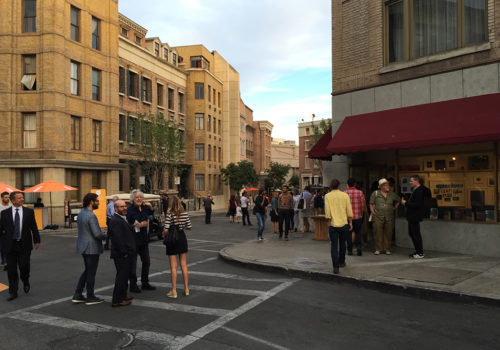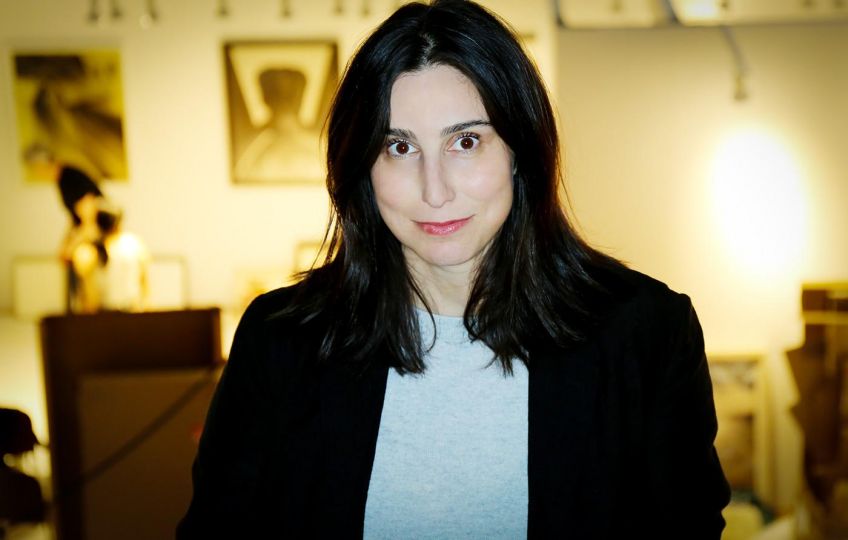Paris Photo is like no other art fair. Between the sun, the California palm trees and Paramount’s New York backlot, it’s difficult to tell where you are. No suits, no ties, no stilettos for the opening. VIPs and collectors strolled through the outdoor stands, drinking Ruinard in plastic flutes and sitting on bistro chairs outside of food trucks. Thomas Von Lintel of the Galerie Von Lintel, Los Angeles, pointed out Drew Barrymore and Jamie Lee Curtis. No paparazzi, no bodyguards. The atmosphere was casual and convivial.
The choice of artwork by the galleries was just as eclectic. Sound Stages 31 and 32 were transformed into exhibition halls, and featured the major galleries—Catherine Edelman, Hamiltons, M+B, Robert Morat—which have participated in the fair since it began. New in 2015 is a hall devoted entirely to up-and-coming galleries, which make up the majority of the Los Angeles gallery scene. Overall, the festival featured a very international selection with Northern Europe most represented. Asia was all but absent.
As for the pictures, no major discoveries, only the pleasure of seeing a certain number of artists again. The prize for the best stand goes once again to Tim Jeffries (Hamiltons, London) with magnificently lit photographs by Guido Mocafico. I have a weakness for Gregory Scott’s Magritte-inspired videos (Catherine Edelman, Chicago). Grimm (Amsterdam) has some beautiful photographs from Désirée Dolron in an intimate and somewhat isolated space. At Martin Asbaek (Copenhagen), two large-format works by Ebbe Stub Wittrup.
Oddly, in the midst of all these contemporary works comes a surprise: the Arnold Archives, presented in a section called CALIFORNIA UNEDITED! The curator, Anthony Lepore, selected these portraits for their impressive technical qualities and strong emotional content. The eyes of the subjects are marked by suffering but are filled with utter determination. They were pioneers who had left everything behind, crossed oceans and deserts to found what would become the factory of the world’s dreams: California.
I didn’t know any of the galleries in Hall 14, even though Clémentine de la Féronnière is located on the Ile-Saint-Louis in Paris, just a few steps from my gallery! Her specialty is in-depth works with a few artists aiming towards the publication of a book. One book per year, one exhibition per year. The photographs of Pierre-Elie de Pibrac caught the eye of the Los Angeles crowd. A large one was on display at the Art Lexing (Miami) stand. Also popular were the architectural photographs by Tom Evangelidis (Black Eye, Darlinghurst, Australia).
One last stop at Stage 31 for another look at Danish photographer Jacob Gils’ trees (In the Gallery, Copenhagen) and, on the New York backlot, Christophe Gaillard’s tulips. I admit that I let myself be fooled by the fake biographies that photographers post about themselves on the internet. I was led to believe that it was an American artist who died twenty years ago. No, he’s alive and well and (apparently) French. Nonetheless, his Polaroid montages of tulips and the beautiful photographs from the series Flammes turned heads.
The day after the opening, I gathered the first impressions of the new festival directors, Florence Bourgeois and Christoph Wiesner, over a glass of cranberry juice in the VIP area. It was obvious that they were unable to truly make a mark on this new edition, having only taken the reins at the beginning of the year. With so little time, they focused their efforts on a few key areas. First, provide a space for emerging galleries (less than six years in operation). Hall 14 was reserved for them. FB and CW imagined a much more fluid layout in the traditional halls, with open stands, varied and connected spaces, in order to create more of a flow between the galleries. The early reactions were highly positive. Logically, the work of the finalists for the Introducing Prize (underwritten by JP Morgan) were exhibited in this Hall. The candidates who were part of schools and universities were featured in the Salon. The winner was CJ Heylinger of UCLA for the series Hell Mirage (2015). Another aim was to anchor the show within the city. Introducing is a first step in this direction, as well as a partnership with the UTA Talent Agency.
Not wanting to unveil future plans, the directors of the fair want to go further with the steps taken this year, like the Conversations, which aim to bring together the worlds of photography and the moving image. For example, the screenings were hosted by visual artists like Allen Ruppersberg and Hirsch Perlman.
It’s still too early to say how this year’s edition will turn out, but it appears to have made a leap forward since last year. We’re optimistic.
















